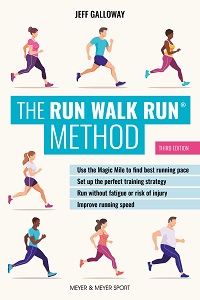Principles Behind the Run Walk Run
Excerpt from The Run Walk Run® Method, by Jeff Galloway – Meyer & Meyer Sport – 2024
 I believe that the most empowering part of Run Walk Run is that it is a cognitive strategy— giving you control over your exercise, attitude, fatigue, and energy.
I believe that the most empowering part of Run Walk Run is that it is a cognitive strategy— giving you control over your exercise, attitude, fatigue, and energy.
Our human organism is designed to improve and repair itself when a gentle stress is followed by a recovery period. Running continuously will cause a stress buildup that can be eliminated when walk breaks are taken early and often. During each walk, the body’s systems can adapt, the orthopedic units can rebuild and restore themselves. Here are some of the principles behind this process.
- Continuous use of a muscle results in quicker fatigue. During a walk break the muscle can adapt, recover, erase fatigue, and rebound to perform better and longer.
- The longer the run segment, the more fatigue. Many runners run faster by reducing the run segment and walking more frequently.
- Run Walk Run is a form of interval training. The human organism can handle a gentle increase in stress if there is a recovery interval regularly inserted. Knowledgeable coaches have used this interval training concept for over a hundred years to prepare athletes for increased distance and speed.
- Conservation of resources. Running continuously uses up energy resources and muscle performance more quickly. When walk breaks are inserted early and often enough, there is more fuel in the tank later in the run. In addition, muscles are revived during each walk break. This means little or no slowdown at the end.
- Elimination of cramping. After analyzing the reports from thousands who have cramped during training runs and races, I’ve found that the leading cause is non-stop running. The right Run Walk Run strategy, from the beginning, has eliminated cramping for most who have suffered from this painful experience.
- Quicker recovery. Walk breaks allow for muscles to recover faster from any workout. The earlier and the more frequently walk breaks are inserted, the quicker the recovery and the sooner one
 can resume the desired type of running. Time goal runners can do the strenuous speed sessions needed to improve. Fitness runners can resume regular activity, and enjoy activities with friends and family even after extremely long runs. Frequent walk breaks allow even first-year runners to enjoy the satisfaction of finishing half marathons, and even marathons, every month.
can resume the desired type of running. Time goal runners can do the strenuous speed sessions needed to improve. Fitness runners can resume regular activity, and enjoy activities with friends and family even after extremely long runs. Frequent walk breaks allow even first-year runners to enjoy the satisfaction of finishing half marathons, and even marathons, every month.
- Less stress on the weak links. Most runners experience downtime due the irritation of a few sites in a few body parts. Without using Run Walk Run, these aches, pains, and injuries occur over and over again, due to individual range of motion, genetics, etc. Running continuously will continue to build up the stress and damage, often resulting in an injury. Each walk break can release the stress buildup, allow the tissue to adapt, or shift workload to other areas. I’ve heard from hundreds of runners that had been diagnosed with serious orthopedic problems and assumed they would have to stop running. A liberal insertion of walking, from the beginning of all runs, has brought these folks back into running—often allowing for running longer distances again.
- Enjoy endorphins during the run. Endorphins help to manage pain from running and can deliver a side effect of improving attitude and injecting relaxation, making one feel better than before. The body organism stimulates endorphin release when one starts running. When running continuously, the endorphins tend to be needed to kill the pains and aggravation of running. Most runners experience the endorphin afterglow of a run, but Run Walk Runners can get the attitude boost during many of the walk breaks. Because a gentle walk doesn’t generate continuing damage, there is no new pain produced. The endorphins can then inject their good attitude hormones into receptor sites in billions of cells throughout the body.
- Reduce core body temperature increase. Running is a lot more work than gentle walking, and produces a significant increase in the core body temperature on a hot day. Running on a day in which the temperature is 60°F (14°C) or higher will result in heat buildup, more sweating and dehydration, and more work for the body to keep you from overheating. Running continuously can keep building heat stress on the body, resulting in heat disease, slower times in races, longer recovery, and loss of desire to run. The early and frequent insertion of walk breaks has significantly reduced temperature increase in my clients who have had heat problems previously, allowing
 them to adapt to running in warm weather.
them to adapt to running in warm weather.
About the Author
Jeff Galloway was an average teenage runner who kept learning and working harder until he became an Olympian. He is the author of the bestselling running book in North America (Galloway’s Book on Running) and was a Runner’s World columnist for more than 20 years, as well as an international speaker for more than 200 running and fitness sessions each year. His Run Walk Run(R) program has inspired millions to run and improve their running. His program’s 99% success rate is based on Jeff’s success with more than 500,000 runners.
